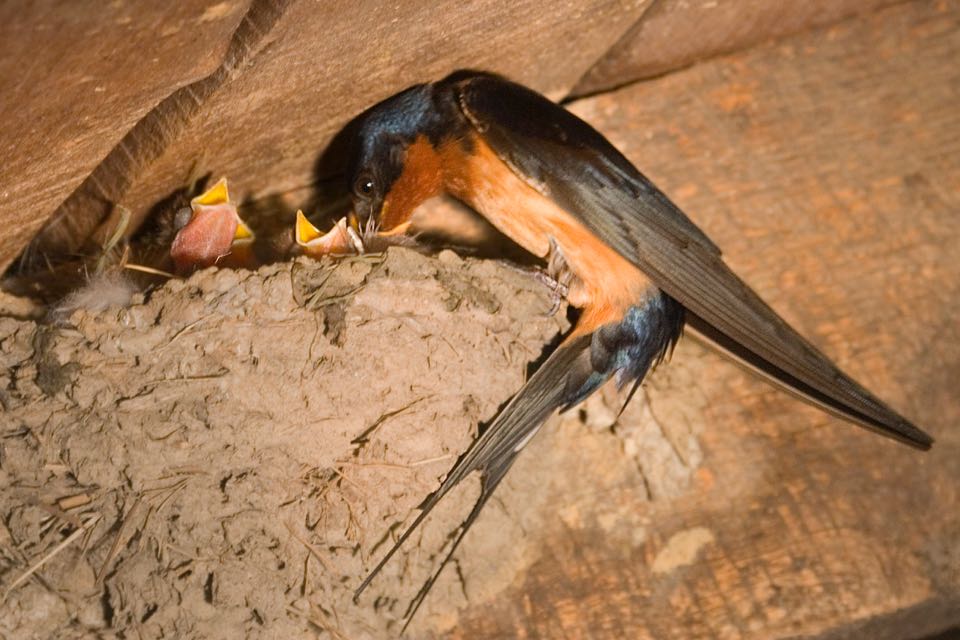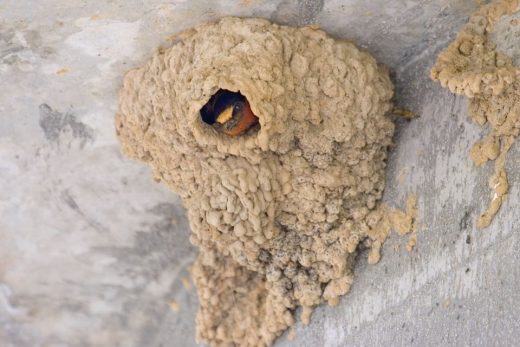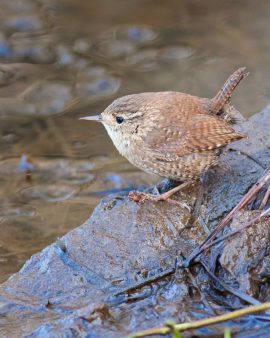By Ashley Peele

Barn Swallow Feeding Nestlings (Bob Schamerhorn)
Halfway through the second field season of the VABBA2 project, many volunteers are turning their thoughts toward completing their Atlas blocks. Unlike many other breeding bird surveys, the Atlas project methods focus on completing a given block then moving on to others. There is no repeat-survey of the same block once completed, thus allowing volunteers to cover more areas over the five years of the project. Until recently, few Atlas blocks were surveyed sufficiently to be classified as complete, but efforts by our dedicated volunteers have now pushed many into this category.
Knowing how to gauge whether a block has sufficient coverage and effort to be ‘complete’ is an eternal challenge of breeding bird atlases. Some blocks will only have one or two habitat types and perhaps 30-40 potential breeding species. Others may be very diverse and have over 100 species present. Such variation makes it difficult to set benchmarks that apply to every Atlas block and situation. For this reason, we established a set of general criteria that Atlas volunteers can use to guide their survey efforts and assess whether they have sufficiently surveyed their Atlas block(s). However! Meeting all of these criteria is challenging. At times, compromises must be made for the sake of efficiency. With that in mind, let’s review the various completion guidelines and answer some commonly asked questions…

Cliff Swallow Nest (Bob Schamerhorn)
1. Surveys in a block should total at least 20 hours spread over multiple visits.
- Data from past atlases show that 75-80% of breeding bird species within a given block are detected in the first 16-20 hours of survey time, if all major habitats are visited. After this time, detections decline and attempts to find 100% of the breeding species present lead to inefficient effort.
- If you do not add new species to your list in a couple trips, consider moving on to another block. A rule of thumb is that you should try not to spend more than 40 hours in a single block.
2. All habitat types present in a block have been visited (if accessible). Realistically, covering every square meter of your block is neither feasible nor productive. Instead, strive for thorough coverage of each available habitat type.
- This goal is more important than attempting a fast survey of your entire block. Some species cannot be found along edges like road sides. When possible, get off roads and travel by foot. Even short walks or stationary counts away from a noisy road can lead to much better observations and block coverage.
- However, remember to always acquire permission prior to entering private lands. Trespassing hurts the reputation of both the project and the birding community and is never permissible.
- Additionally, please be aware of and abide by all access regulations for public lands. Note! Atlas volunteers can access VA Wildlife Management Areas for free! Just email the state coordinator for an access letter.
3. Surveys should be spread out over different times of the year. It is very important not to limit field observation time to peak months (late May – July).
- Early or late breeders may only be detected if one or more visits are also conducted in late winter and late Summer. For example, the best time to detect American Woodcock is in late January- March and American Goldfinches often don’t begin breeding activity until late July or August.
- Consider June-August as the months for upgrading singing birds detected earlier in the season from Possible or Probable to Confirmed status.
4. At least 2 night visits should be conducted. Simply put, most nocturnal species will only be detected on nocturnal visits. Such visits are critical for documenting owls, nighthawks, Chuck-Wills-Widow, etc.
- Remember that separate eBird checklists are necessary for daytime and nighttime visits. eBird will classify your visit as nocturnal if it ends earlier than 40 minutes before sunrise or begins later than 20 minutes after sunset.
- While confirming that a nocturnal species is breeding in a given block is challenging for anyone, simply documenting presence is valuable data for the Atlas.
5. At least 50% of species detected are confirmed as breeding. The overarching goal is always to upgrade as many species to ‘Confirmed’ breeders as possible. For example, if you have 50 species detected in your block, strive to confirm breeding in 25 (50%) of those species.
- However, please do not spend significantly more than 30-40 hours per block, in an effort to reach 50% confirmations. After investing this many hours of focused Atlasing effort in a block, you’re unlikely to accumulate significantly more breeding confirmations without many more hours of effort. The overall project will benefit more from volunteers moving on to a new priority block at this point.
- A helpful method is to review what species are still in need of confirmation. If a subset of these are species that you feel you could confirm with one or two more trips, then go for it! However, if you feel that further confirmations in your block would require many more hours of effort, consider moving on.
- Consult with your RC, if you’re uncertain as to whether you should continue working in a new block or move on to a new area.
6. Species detected in a block should equal at least 80% of confirmed breeding species documented in that same block in the first Atlas. Because the number of species will vary widely between blocks, atlasers should not focus on documenting an absolute number as a goal.
- A useful objective is instead seeking to document a percentage of the species recorded within a given block during the first Atlas. Lists of breeding species identified in the first VABBA for each atlas block can be found for each block via the Atlas Block Explorer and Mapping tool on the Atlas website (addresses below).
- Remember that this is just a guideline and conditions may have changed in your block, affecting what species are now present. You will also find that many blocks had very low effort in the first Atlas and thus very small species lists. Don’t let this limit your own efforts to build a more thorough list this time around!

Winter Wren, Mechanicsville (Bob Schamerhorn)
These parameters represent the cumulative effort that volunteers should attempt to achieve for block completion. However! Meeting all of these criteria will be a challenge. The guidelines above are listed in order of importance. Strive to meet at least the first four criteria, then assess where you stand relative to your effort and criteria 5 and 6.
Remember that you can use the Block Summary Card (available on the Atlas website) to keep track of the species total and effort in your Atlas block. Additionally, eBird can be used to track your progress in a given block. When you believe that you have completed a block, notify your regional coordinator. A statewide review effort will begin this Fall to verify current block completions.
Lastly, a block should be completed within one or two years of sign up. We need to cover many, many blocks in Virginia over the remaining 3 years of the Atlas project (2018-2020), so make the most of your time in the field. Please sign up for blocks that you intend to survey within 1-2 years. When these are completed within the project parameters and a block has been reviewed by your Regional and Atlas coordinator, consider signing up and surveying other priority blocks. This will the most efficient use of the time you are donating to the VABBA2.
On this final note, thank you so much for striving to be informed Atlas volunteers. The project leadership appreciates all of the folks working hard to complete Atlas blocks and increase coverage in their respective regions.
Links to web tools mentioned above:
Atlas website: www.vabba2.org
Atlas Block Explorer and Mapping Tool: https://amjv.org/vabba/maps-and-tools/ (Also where volunteers can sign up for blocks)
Downloadable PDF of Atlas Handbook: http://amjv.org/resources_vabba2/VABBA2_Handbook_Draft_Final_2017.pdf
~ Dr. Ashley Peele, State Coordinator, 2nd VA Breeding Bird Atlas (VABBA2)

